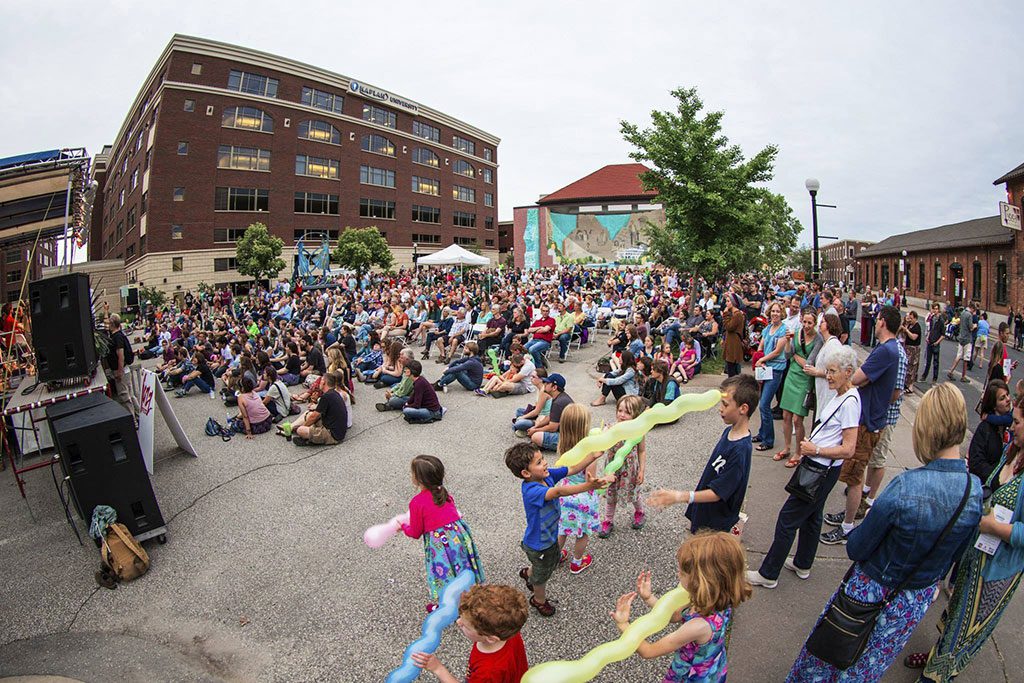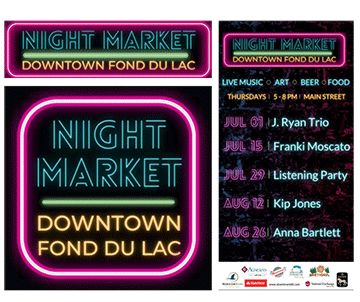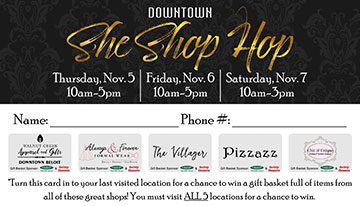
Developing and executing the correct plan allows event managers to increase event attendance, build meaningful connections with attendees, and add positive economic impact to the community.
January 2023
It takes a lot of planning to stage a successful downtown event, whether it’s a festival, wine walk, farmers market, music in the park, etc.
Determining what your event will be is just the beginning. There are many other factors to consider, such as the image you want to create for your event, how to publicize it, and how to gauge its impact.
Getting an early start is essential, and there are several steps you can take to jump-start the planning process, keep it on track, and maximize your event’s success.
Suggested timeline:
- 10 to 12 months before the event: Set goals, define audience, and establish objectives.
- 8 to 10 months before the event: Create an event brand.
- 3 to 6 months before the event: Formulate a marketing strategy.
- 1 to 2 months before the event: Create an evaluation strategy.
- 2 to 4 weeks following the event: Evaluate your event.
Executing these steps successfully will allow event managers to increase event attendance, build meaningful connections with attendees, collect feedback, evaluate economic impact to the district, and make decisions on each event’s future.
Step 1: Event branding
 The first steps in successful event management are setting goals, defining the audience, establishing objectives, and creating the event’s brand. Marketing managers should aim to know their goals, audience, and objectives as early as one year before the event. Branding should be ready to go 8 to 10 months before the event.
The first steps in successful event management are setting goals, defining the audience, establishing objectives, and creating the event’s brand. Marketing managers should aim to know their goals, audience, and objectives as early as one year before the event. Branding should be ready to go 8 to 10 months before the event.
Event branding means capturing the essence of your organization and its event in a way that tells your visitors exactly what sort of experience they can expect. When done properly, branding creates a connection so that the next time you hold an event, people will not only recognize that the event belongs to your organization, but they will be excited to attend based on their previous experience with the brand.
Event branding encompasses a range of elements, and the more recognizable those elements are, the more memorable the brand—and your event—will be. The ways you brand your event will differ from ways you brand your organization. They should be similar but not the same. You can consider your event brand to be like your organization’s brand with a different spin.
Event branding basics: Creating brand visuals and design for your event
Distill it down. Ask yourself these important questions when creating your event’s brand:
- What is the purpose of the event?
- Who is your target audience?
- What do people need to know?
Plan the look.
- Use your organization’s branding to begin to plan the way you want your event to look.
- Find images from similar events around the state. This will help you discover ideas and designs that you like or don’t like. Choose the visuals that will promote the image you want for your event and build on them.
- Sometimes it is useful to start with a phrase before creating the visuals. This should be a simple phrase that explains the point of the event. For example, for an art walk, “artsy and energetic,” or for a restaurant week, “curated menus of the best downtown cuisines.”
Once you plan your design, edit it strategically to achieve the best brand design for your event. This involves three steps:
- Refine your design.
- Choose the direction of the design. If it feels like the design is starting to make sense but isn’t quite ready, this is normal; just keep working on and refining the design until it all comes together.
- Think about context.
- Where will this branding be implemented and displayed? This could include web banners, printed materials, social media posts, and other forms of publicity.
- When you think about the context and where and how the design will be implemented, consider how the layout will change and adapt for the different media.
- Edit, edit, edit!
- Self edit: Some key steps will help you edit your own design.
- Note your immediate reaction if an element doesn’t seem to fit.
- Pull out the answers to your initial questions about the event’s purpose, its potential audience, and what people need to know.
- Print the design and scribble your notes and changes on the printout.
- Go over the ways you plan to use the branding and ask yourself if the design will translate well into the various uses in terms of colors, visual treatments, and logos.
- Team edit: Once you have refined the design to your liking, utilize your team to get a new set of eyes on the design.
- Set up your team for success by explaining your project’s objectives.
- Don’t tell the team what you don’t like about the design. Emphasize what you do like and ask for suggestions.
- Outsider edit: Get a completely outside perspective on design. Ask someone who is not involved in your project to take a stab at editing the design.
- Ask: What does the visual seem to be saying? Is there anything bugging you about it? How legible is the design?
- You can find outside editors through arts councils, graphic design groups, creative peers, mentors, family, or friends.
- Self edit: Some key steps will help you edit your own design.
Thoughtfully created event branding takes time, but it will be worth it.
Step 2: Event marketing
 The next step in successful event management is making sure the marketing strategy is well planned. Event managers should have their event marketing in place three to six months before the event in order to schedule and implement all marketing elements in a timely manner. Event marketing is all about letting people know you are hosting an event and inviting them to participate. It encompasses the strategy to promote an online or offline event through various channels. Whether it’s a wine walk, a farmers market, music in the park, a neighborhood festival, or any other event, marketing it well will create buzz and entice people to come.
The next step in successful event management is making sure the marketing strategy is well planned. Event managers should have their event marketing in place three to six months before the event in order to schedule and implement all marketing elements in a timely manner. Event marketing is all about letting people know you are hosting an event and inviting them to participate. It encompasses the strategy to promote an online or offline event through various channels. Whether it’s a wine walk, a farmers market, music in the park, a neighborhood festival, or any other event, marketing it well will create buzz and entice people to come.
Some of the best ways to promote your event are to publicize it through the news media, tap into social media, and email your target audience. Make it clear to people that they will have a good time at your event—perhaps even to the point that that they will feel a fear of missing out (FOMO) if they don’t attend.
News media
Sharing your event with the media may be one of the easiest ways to get the word out to a wide audience. Write a news release and distribute it to all of the print and broadcast outlets in your area. Invite local media personalities to participate in your event and to promote it in advance. This can result in broadcast interviews, newspaper and magazine articles, and public service announcements.
Social media
Next, think about social media platforms. The social media platform you use to market your event will also define your tactics. For instance, Instagram is the best place to post visuals, and Facebook is the best place to reach a large audience of people with a wide range of demographics and interests.
A good way to use social media to market your event is to structure your social media campaign around deadlines, announcements, and reminders. Use your profiles to make key announcements and remind attendees of key dates.
Facebook is a great platform to get the word out. Create a Facebook event page for your event. That will give you a central hub for your event that is easy to promote. You can invite everyone who follows your page, and they can invite their friends to join. In addition, you can utilize your Facebook page to repost your event page to gain maximum exposure.
You may also want to consider going live on Facebook to promote your event. A livestream is a new trend in event marketing that allows you to have direct interaction with your target audience and invite them in. Use this opportunity to give your audience a peek into what awaits them and make a compelling pitch about why attending the actual event is something they don’t want to miss.
Email marketing
With social media squared away, it is time to plan your email marketing campaigns for the event. Using email to market your event is one of the most effective ways to reach your target audience and has the highest rate of return; it can make a world of difference in the number of attendees you get. After all, everyone uses email. People check their email in the morning, throughout the day, and sometimes even when they should be sleeping.
To make your event successful, you want to reach a large audience personally and repeatedly. For that, email marketing is the tool of choice. It will help you reach the right audience and build and maintain interest from registration up to the day of the event. It creates a built-in mechanism for collecting feedback after the event. It will also increase the chance that past attendees will return by reengaging members of your list who may have not been active recently.
Key tips for creating an effective email marketing strategy include:
- Capitalize on FOMO. Make readers feel that they will miss out if they pass on this opportunity. You can do this by sending emails with captivating subject lines, such as: “It’s now or never,” “Tickets selling fast,” or “Limited number of tickets available.”
- Generate suspense. Launch your promotions early to create a feeling of suspense and curiosity about the event. For example, you might send event emails with the subject line: “Keep an eye out for Wine Walk tickets, coming soon” or “Watch this space for more details on the festival headliner.”
- Send an early bird ticket offer. Early bird offers imply that the event will be highly popular and the same ticket will cost more later on. This also sets the tone that you are offering these readers a privilege, making them more inclined to take up the offer.
- Promote acts, vendors, and businesses that are involved in the event. Introduce your performers, vendors, and businesses to create buzz about their presence.
- Make it easy for people to ask questions. Make the email a two-way conversation. You can do this by guiding readers to your website or your social media handles for a fast response. A quality conversation often goes a long way in forming meaningful customer relationships.
- Add event banners in your email signatures. This is a common yet powerful practice that ensures every email communication your organization sends also carries information about your upcoming event.
- Link to social media. Include your social media handles and widgets within your email body. When the target audience receives the same key message from all popular channels, it has a multifold impact on the brand awareness of your event.
- List prizes. Motivate people by letting them know what kind of prizes they could win—if they attend your event.
Spark FOMO and promise a good time
Creating FOMO is a popular tactic to engage your audience and make them feel like they need to be at your event. Contrary to popular belief, people are more interested in an event when they feel they will lose out on something valuable if they don’t attend. For example: “You don’t want to miss this event” is a simple but effective marketing subject line, social media campaign, or blog post to engage curiosity about your event. Multimedia content like video, images, and user-generated content can help reinforce this impression. Think of it like a movie: When the trailer comes out, people start talking about it and can’t wait to go see the full movie. A sneak peek will show your audience you’ve put in the effort to make this a memorable, fun, and rewarding event.
Step 3: Event evaluation
 The process of managing your event would not be complete without an evaluation of the event—ideally, two to four weeks after it occurs. Managers should make sure their event evaluation strategy is ready one to two months prior to the event. It is important that event hosts have a regular process of reviewing what went well and what could be improved. An event is not successful just because it happens. Some events are memorable and will draw a big crowd while others might not—and that is OK. Evaluation can tell you if the event achieved its goals, and you can decide if it makes sense to hold the same event again, make some tweaks, or decline to offer it again and free up time for other, more effective initiatives.
The process of managing your event would not be complete without an evaluation of the event—ideally, two to four weeks after it occurs. Managers should make sure their event evaluation strategy is ready one to two months prior to the event. It is important that event hosts have a regular process of reviewing what went well and what could be improved. An event is not successful just because it happens. Some events are memorable and will draw a big crowd while others might not—and that is OK. Evaluation can tell you if the event achieved its goals, and you can decide if it makes sense to hold the same event again, make some tweaks, or decline to offer it again and free up time for other, more effective initiatives.
Events that will be repeated still need to be evaluated and updated to maximize the return on investment of time and effort involved. Some questions you ask might include:
- What were the goals? Were they achieved?
- Did the event break even (or come close) when staff and volunteer time are factored into the equation?
- How did visitors, merchants, vendors, and other stakeholders feel about the event? What suggestions do they have to make it better?
Answering these questions requires information on numbers (e.g., attendance, revenues) and perceptions (visitor experience). While it can be intimidating to ask visitors for input, their perspectives can be incredibly valuable. Even negative feedback to the planning team is better than unfiltered thoughts shared over social media. It is important to have some way of gauging an event’s success to make the next event even better and to ensure the lessons of the event are kept in mind when planning begins for the following year.
Collecting data
- Traditional methods: Best practices for event evaluation start with launching those efforts early. Event apps (such as Eventbrite) give you the ability to engage with your customers while also collecting demographic and other information about your audience. People can send their concerns and questions through these apps as well, making it easier for both the customer and the organizer to collect feedback and take it into account. In addition to these digital tools, you can set up information areas at the event to encourage people to share their ideas and experiences with staff immediately, while they are still at the event. In addition, it is important to ask the right questions, and smart evaluation surveys will have these questions built in, with sections for attendance and sales totals, post-event surveys for visitors, and interviews with stakeholders.
- Geofencing: In addition to the tried-and-true forms of data collection for event evaluation, there is a new player in the field: geofencing. WEDC and the Wisconsin Main Street team now offer geofencing services to all our Main Street communities. Geofencing uses GPS or radio frequency identification device (RFID) technology to create a virtual geographic boundary, enabling software to trigger a response when a mobile device enters or leaves a particular area. With this data, we can provide detailed event reporting to differentiate between local event attendees from those who traveled from a farther geographic area to attend the event. Other data we can collect for events includes demographic information, top source markets for the event, a year-over-year look at past events, and a breakdown of first-time visitors and repeat visitors to your district.
- Interviews, surveys, counts, and fun facts: Interviews, surveys, and counts are the top three activities to collect data and effectively evaluate your event. They can also help create visitor and vendor profiles that can be used for future event planning and continued relationship building. Interviews provide uniquely valuable feedback since they allow people to answer open-ended questions in a free-form fashion instead of just selecting multiple-choice responses. Interviews can be done randomly throughout the event by engaging visitors and vendors. Surveys are equally important to collect valuable data on the event’s performance from the perspective of vendors, sponsors, and area businesses. In addition to interviews and surveys, you should have a system set up to count attendees and sales. You can also collect “fun facts” by counting (for example) how many garbage bags were used, how many kegs of beer were emptied, and how many ears of corn were eaten. The fun facts are a great way to engage visitors for future years, since people tend to be intrigued by these numbers. They can also demonstrate to potential attendees what sets the event apart from others.
- Answer the key questions: Once you have collected your data through surveys, counts, and interviews, you have what you need to answer the key questions. First, did you achieve your goals? Monetary goals can be evaluated based on expenses and profits. Don’t forget to assign a value to in-kind contributions as well as staff and volunteer time. Attendance goals can be evaluated based on the counts collected. If your goal was to draw a broader mix of demographics or to increase attendance of a specific group, this can be evaluated using the answers from interviews, surveys, registrations, and social media engagement. How did customers, vendors, and businesses feel about the event? This question can be answered from your surveys and interviews. In addition to these specific metrics that should be evaluated for every event, you will have other ideas of what went well and what didn’t from the feedback you received throughout the event. Make a list of ideas and potential changes for next year now, while the information is still fresh in your mind.
